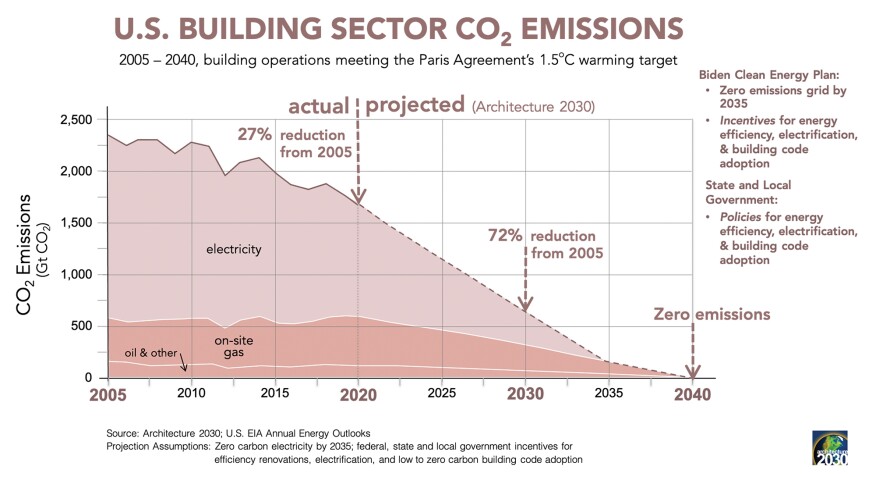Can the U.S. Building Sector Become Carbon Neutral by 2040?
Published on February 11, 2021 by Nate Bortz

In some of our previous blogs, we looked at different building and design methods that are becoming more popular in an effort to reduce the building sector’s carbon emissions. Today, thanks in large part to “greener” building practices becoming more popular over the past decade, industry experts are confident that the US building sector can become carbon neutral by 2040.
How did we get here? And what still needs to be done to make sure we achieve this goal? How can you as a licensed builder help make sure we literally save the planet? Read on to find out.
The Threat
Edward Mazria, the founder and CEO of the nonprofit Architecture 2030, explained the reasoning behind the 2040 goal in a recent interview and why, despite the looming threats to the planet, there are still reasons to be optimistic.
In 2018, the United Nations’ Intergovernmental Panel on Climate Change (IPCC), a collection of the world’s leading climate scientists, issued a report that described the avoidable consequences if we (as in everyone on earth) continued our efforts to prevent just a half degree in the rise of average global temperatures (1.5°C vs 2°C).
If nothing is done and the global average temperature increases by 2°C, instead of 1.5°C,
- 2.6 times more people, or 37% of the world’s population, will be exposed to severe heat at least once in five years.
- Plants and vertebrates will lose twice as much habitat as they would at only 1.5°C of warming; insects would lose 3 times as much.
- The decline of fisheries’ global annual catch will double from 1.65 million tons to 3.3 million tons.
- The rate of sea-level rise will increase 30% by 2100.
Preventing consequences such as the ones listed above is why in 2015 the United Nations established the Paris Agreement, whose goal is “to limit global warming to well below 2, preferably to 1.5 degrees Celsius, compared to pre-industrial levels.”
Today, the planet’s average global temperature has risen by slightly more than 1°C from pre-industrial levels. In Mazria’s view, “unless the world collectively reduces current levels of global carbon emissions 50% to 65% by 2030—and completely phases them out by 2040—it will likely pass the 1.5°C warming threshold.”
These are all serious threats to our planet, but there is good news. According to the US Energy Information Administration (EIA), the country is currently on a promising track.
Making Progress
In the EIA’s 2020 carbon emission report, the building sector’s total operating carbon emissions were 27% below 2005 levels. This means the building sector met the US commitment to the United Nations Paris Agreement of a 26% to 28% reduction from 2005 emissions levels five years ahead of the 2025 target date! In fact, the EIA projects that the building sector’s carbon emissions will continue to decline post-pandemic if we just continue on our present course.
How We Got Here
According to Mazria, even though the U.S. added “more than 50 billion square feet to its building stock, energy consumption in the building sector stabilized in 2005 and has not increased since.” This is in part due to construction firms and builders creating more efficient buildings each year.

The Work Ahead
Although the US is currently trending in the right direction when it comes to carbon emissions, there is still plenty of work to be done in order to meet the 2040 goal. In the US, Mazria sees opportunity for improvement with the upcoming administration. Mainly, by adding “federal, state, and local government incentives and policies for energy-efficient building upgrades, electrification, and the adoption of more efficient and zero-carbon building codes federal programs that reduce carbon emissions.” Below are a few policy examples:
Recently, the International Code Council approved the addition of the “Zero Code Renewable Energy Appendix” into the 2021 International Energy Conservation Code (IECC). The American Institute of Architects (AIA) worked with Architecture 2030 to develop the appendix, which aims to empower “local communities to take action on climate change through building codes.”
The Zero Code Appendix
The ultimate purpose of the Zero Code Appendix is to provide a national and international framework for creating zero carbon buildings. A zero carbon building is defined as one that “uses no on-site fossil fuels and produces or procures enough carbon free renewable energy to meet building operational energy consumption annually.”
The now-approved appendix gives jurisdictions the option to adopt a zero-net-carbon standard as their community’s minimum energy code. Doing so would require all new commercial, institutional, and mid- and high-rise residential buildings to produce or procure enough renewable energy to achieve zero-net-carbon annually. The appendix encourages onsite renewable energy systems when feasible but also supports off-site procurement of renewable energy through a variety of methods. However, this appendix does not allow renewable energy to be traded off against the energy efficiency required by the 2021 IECC.
If you’re interested in learning more about how you can actively build zero-net-carbon buildings, check out the Zero Code’s Energy Calculator.
Federal Possibilities
Another way the US can improve carbon emissions in the building sector is by enacting more federal programs. Since the building sector consumes approximately 74% of the electricity generated in the US, Mazria says he is excited for the Biden administration’s Plan for a Clean Energy Revolution and Environmental Justice. Moving toward carbon-free electricity by 2035 would reduce the building sector’s carbon emissions further, by about 60% below 2005 levels by 2030.
The journey ahead to curbing climate disaster will not be easy. But thanks to efforts by you and your builder colleagues, there is still hope for a healthier planet for our descendants.
